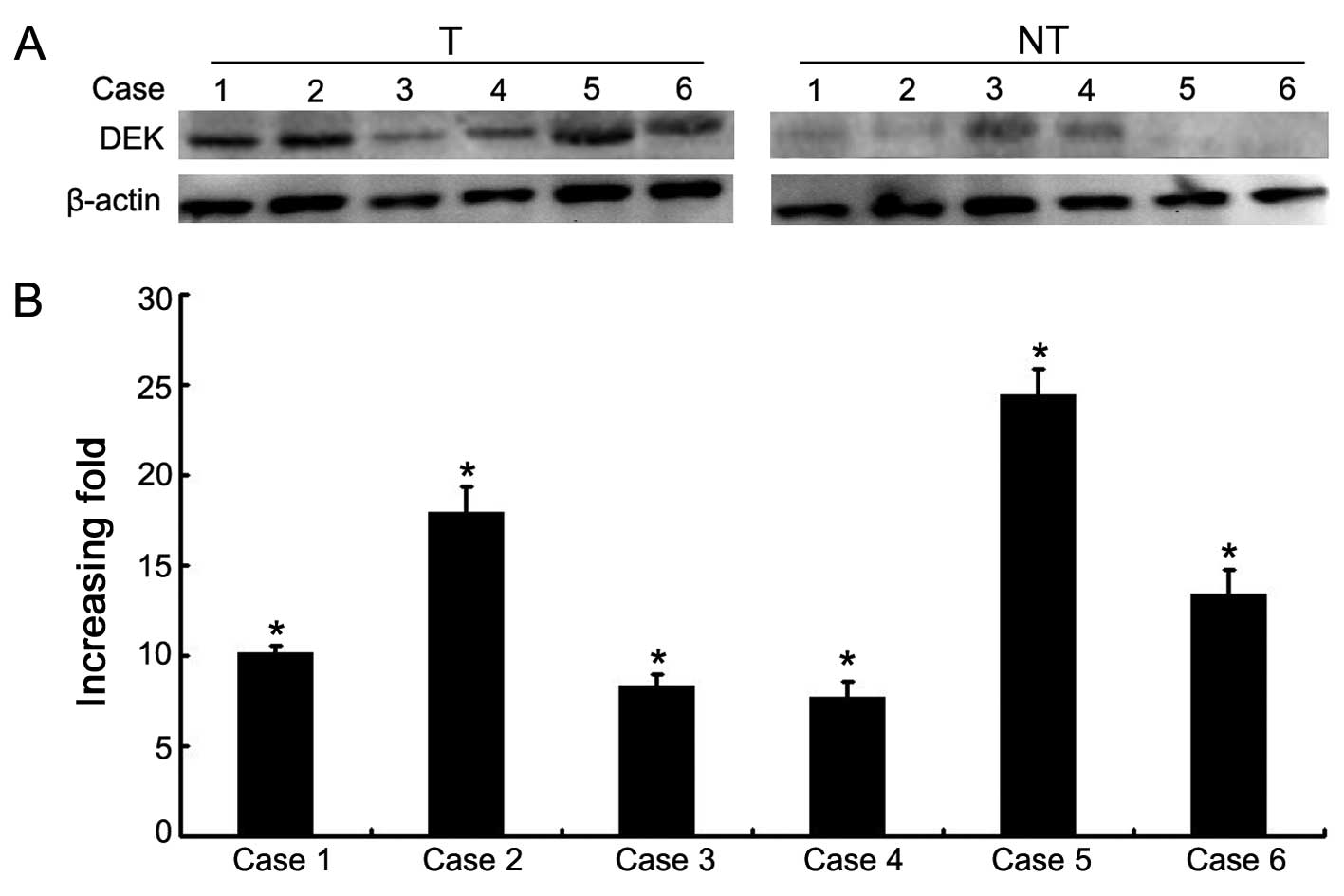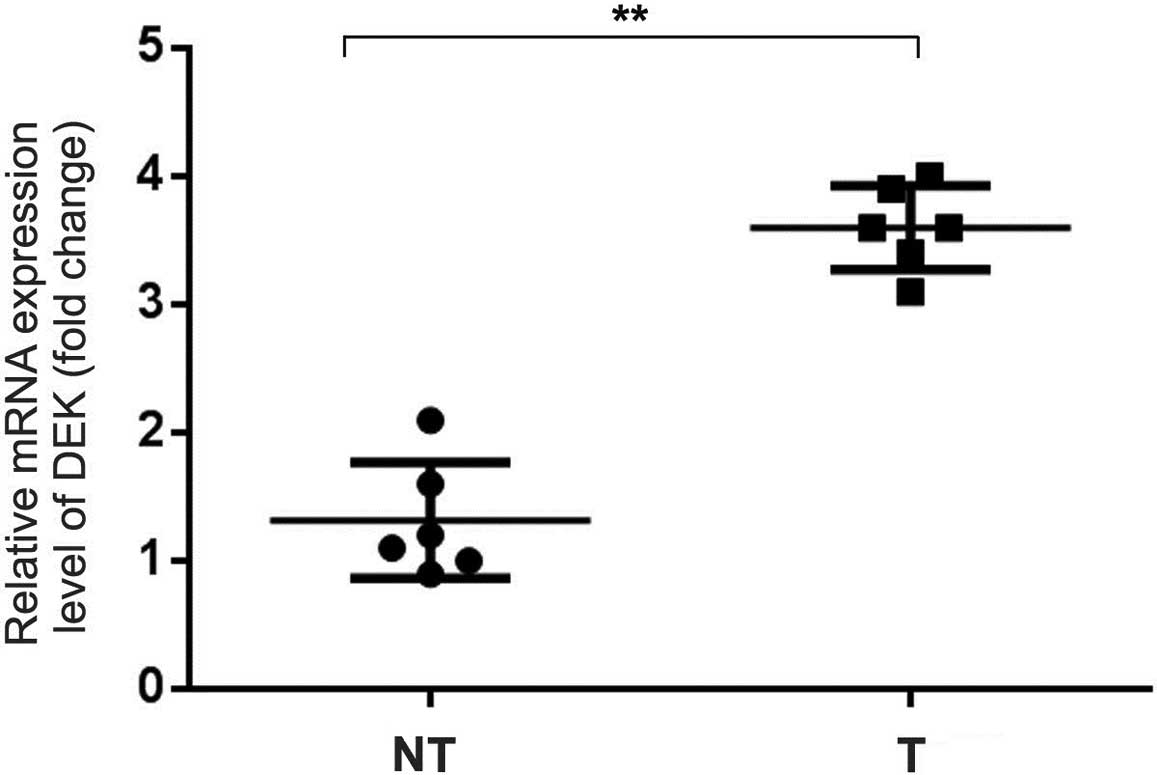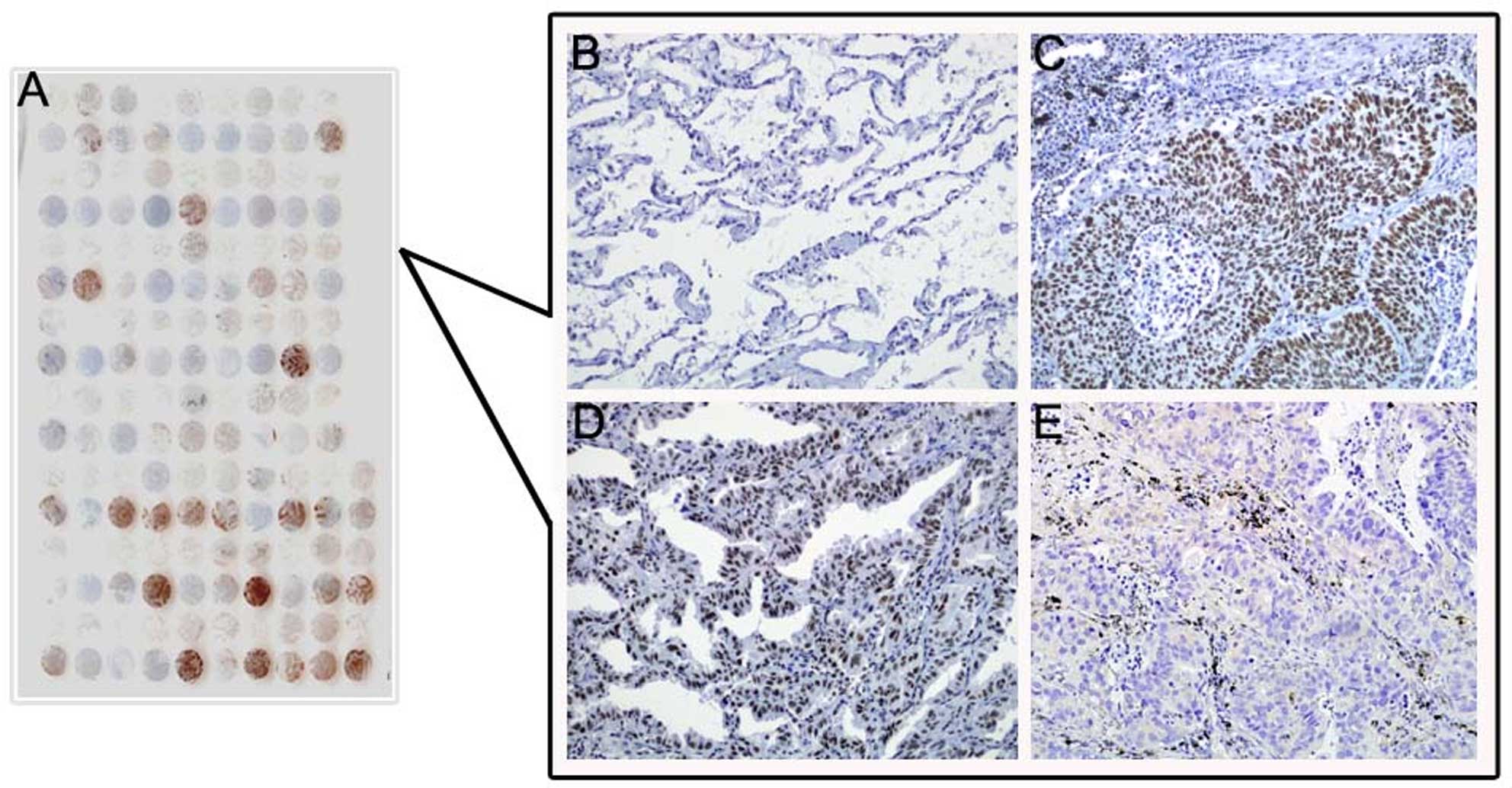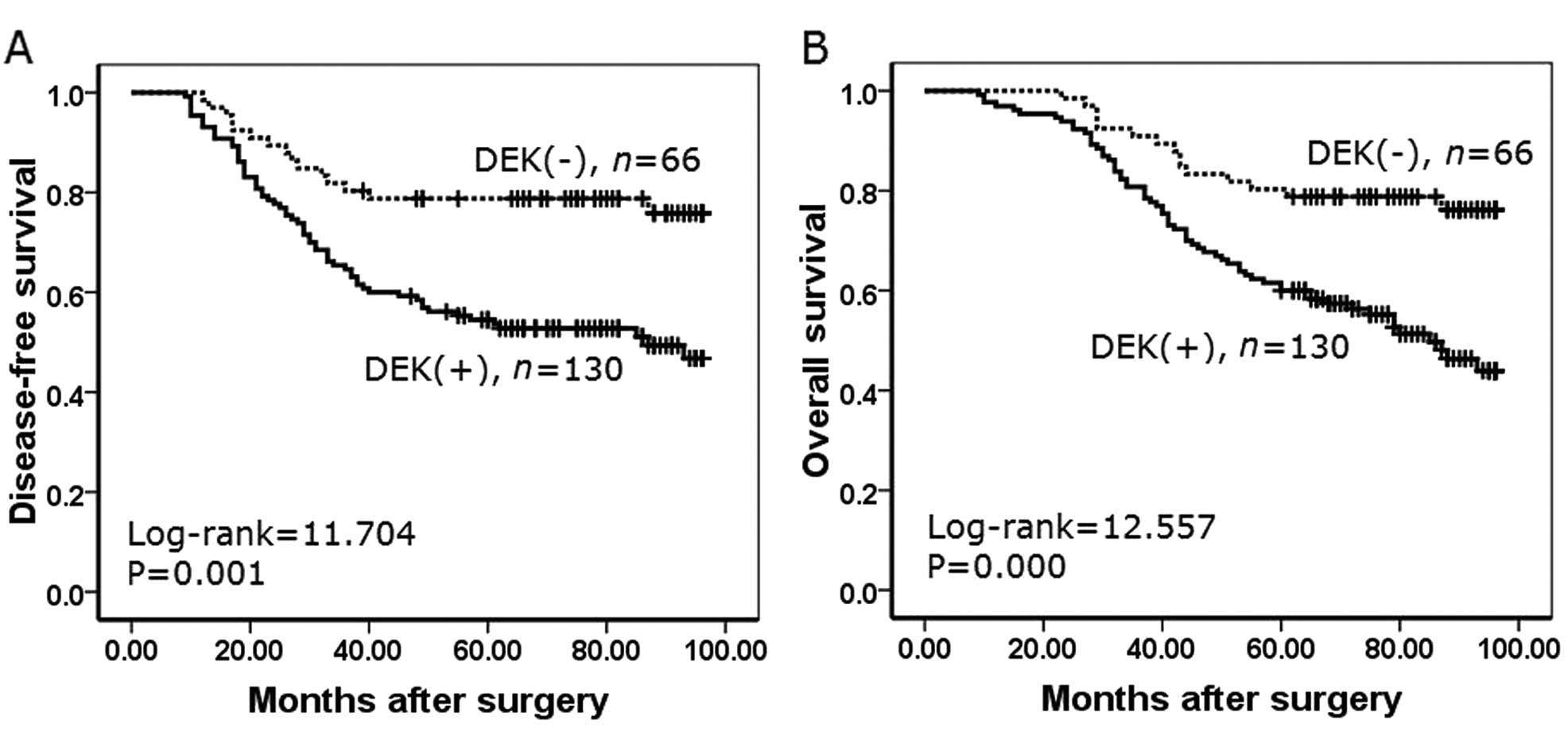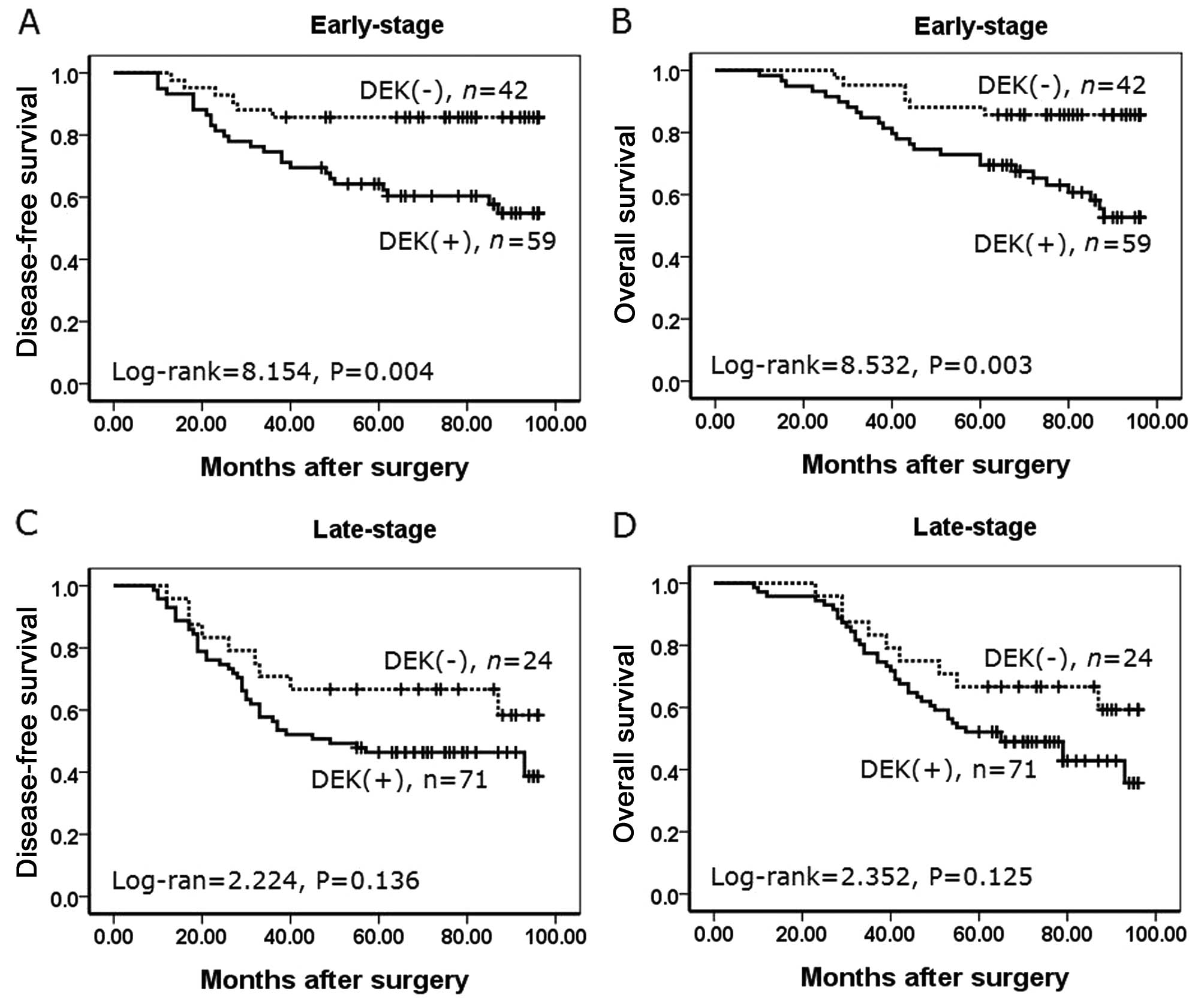Significance of DEK overexpression for the prognostic evaluation of non-small cell lung carcinoma
- Authors:
- Published online on: October 30, 2015 https://doi.org/10.3892/or.2015.4365
- Pages: 155-162
Abstract
Introduction
Lung cancer is a leading cause of cancer-related deaths worldwide with over one million cases diagnosed yearly (1). Lung cancer is morphologically divided into non-small cell lung carcinoma (NSCLC) and small cell lung carcinoma, in which NSCLC accounts for ~80% of all lung cancer cases (2,3). Despite progress in the multimodality treatment of lung cancer, prognosis is still poor with a 10–15% 5-year survival rate. Therefore, the identification of a reliable biomarker for predicting recurrence and for identifying tumors is important not only for understanding the molecular and cellular processes involved, but also for searching for possible new therapeutic molecular targets.
The proto-oncogene protein DEK was originally identified as a fusion with the CAN/NUP214 nucleoporin in a subset of acute myeloid leukemia patients (4,5). DEK is abundantly expressed in proliferating cells, and the majority of the protein is bound to chromatin, whereas a small fraction is bound to RNA. The 43-kDa nuclear phosphoprotein is the only member of its family, and contains a conserved central SAP DNA binding domain with homology to SAF-A/B, acinus and PIAS, and a second DNA binding motif within the C-terminus. Studies have suggested that DEK may promote tumorigenesis, at least in part, by its ability to interfere with cell division, DNA repair, inhibit cell differentiation, senescence and apoptosis, and cooperate with transforming oncogenes (6–9). Wise-Draper et al recently reported that DEK expression promoted transformation in vitro and in vivo and the DEK proto-oncogene is upregulated in many human cancers including colon, breast, ovarian and cervical cancer (5). The degree of DEK upregulation often correlates to the severity of prognosis as indicated by histopathological determination of a later stage and grade, or poor differentiation characteristics (5,10). Our previous studies showed that DEK protein was closely related to the proliferation of serous ovarian tumor cells and an increased proliferating index of Ki-67 in cervical cancer (11,12). Furthermore, based on tumor tissue analyses, we found that DEK expression was correlated with the prognosis of a variety of human tumors, such as breast and colorectal cancer (13,14). Thus, DEK is expected to be the new molecular target for cancer therapy. However, the role of DEK in the prognostic evaluation and its relationship to survival in NSCLC are unknown. The critical role of DEK in numerous cancers impelled us to study the function of DEK in NSCLC. Therefore, we performed immunofluorescence (IF) staining in NSCLC A549 cells, and quantitative real-time RT-PCR (qRT-PCR), western blotting and immunohistochemical (IHC) staining of DEK in NSCLC and normal lung tissues, and found that DEK protein was usually upregulated in NSCLC compared with the normal counterparts. Multivariate analysis revealed that DEK may be an independent biomarker for predicting NSCLC prognosis.
Materials and methods
Ethics statement
The present study complied with the Helsinki Declaration and was approved by the Human Ethics and Research Ethics Committees of the Medical College of Eastern Liaoning University in China. Through the surgery consent form, patients were informed that the resected specimens would be stored by the hospital and potentially used for scientific research, and that their privacy would be maintained. Follow-up survival data were retrospectively collected through medical-record analyses.
IF staining for DEK protein in non-small cell lung cancer cells (A549)
The lung cancer cell line, A549, was grown on coverslips to 70% confluency and then fixed in 4% paraformaldehyde for 10 min and permeabilized with 0.5% Triton X-100 for 10 min after 24 h. Blocking was performed with 3% bovine serum albumin fraction V (Solarbio, Beijing, China) for 1 h at room temperature. After washing with phosphate-buffered saline (PBS), the cells were incubated with mouse anti-human DEK (1:50; BD Biosciences Pharmingen, San Diego, CA, USA) at 4°C overnight, followed by incubation with Alexa Fluor 568 goat anti-mouse IgG (H+L) (A11004, 1:1,000; Life Technologies, Carlsbad, CA, USA) for 1 h at room temperature. After washing with PBS, the cells were counterstained with 4′,6-diamidino-2-phenylindole (DAPI), and the coverslips were mounted with Antifade Mounting Medium (both from Beyotime, Shanghai, China). Finally, immunofluorescence signals were visualized and recorded using Leica SP5 II confocal microscope (21).
Clinical samples
Fresh samples from 6 cases of NSCLC were paired with adjacent non-cancerous tissues, and 196 cases of routinely processed and paraffin-embedded NSCLC meeting strict follow-up criteria were randomly selected from patients undergoing surgery between 2004 and 2008 at the Department of Pathology and Tumor Tissue Bank, the Medical College of Eastern Liaoning University. Pathological parameters, including age, gender, smoking status, tumor size, pathological stage, differentiation, subtype, CEA level, metastasis status, disease-free and overall survival data, were carefully reviewed. The patient ages ranged between 34 and 76 years, with a mean age of 64.6 years. The male to female ratio was 109:87. Tumors were staged according to the 6th edition of the American Joint Committee on Cancer (15). Of the 196 NSCLC samples, 101 were determined as early-stage (I–II) and 95 as late-stage (III–IV). Forty-four samples were well differentiated, 94 were moderately differentiated and 58 were poorly differentiated cancers. No patients had received chemotherapy and radiotherapy before surgery. By March 2013, 78 patients had died and 118 patients remained alive. The median survival time was 71 months.
Western blotting
Fresh tissue samples of NSCLC were ground to powder in liquid nitrogen and lysed with SDS-PAGE sample buffer. Equal protein samples (20 µg) were separated on 12% SDS polyacrylamide gels and transferred to PVDF membranes. The membranes were blocked with 5% fat-free milk in tris-buffered saline containing 0.1% Tween-20 for 1 h at room temperature. The membranes were incubated with the DEK antibody (1:1,000; BD Biosciences Pharmingen) overnight at 4°C, and then with horseradish peroxidase-conjugated rabbit anti-mouse IgG. DEK expression was detected using ECL Prime western blotting detection reagent (Amersham) according to the manufacturer's instructions. β-actin (Sigma, St. Louis, MO, USA) was used as a loading control. Protein bands were quantified using a LANE 1D system (Sage, China).
RNA extraction and qRT-PCR
Total RNA from fresh tissues was extracted using TRIzol reagent (Invitrogen, Carlsbad, CA, USA). First-strand cDNA was synthesized by PrimeScript reverse transcriptase (Takara Biotechnology, Dalian, China) and oligo(dT) following the manufacturer's instructions. To examine expression, real-time PCR was performed with a Bio-Rad sequence detection system according to the manufacturer's instructions using a double-stranded DNA-specific SYBR Premix Ex Taq™ II kit (Takara Biotechnology). Double-stranded DNA-specific expression was tested using the comparative Ct method using 2−ΔΔCt. The DEK primers were: 5′-AAACCTAGCCAGCTTCACGA-3′ and 5′-AGCCCC AACTCCAGAGAAAC-3′; GAPDH, 5′-GGTCTCCTCTGA CTTCAACA-3′ and 5′-ATACCAGGAAATGAGCTTGA-3′. All assays were performed in triplicate and repeated at least three times.
Immunohistochemical analysis
Immunohistochemical analysis was performed using a Dako LSAB kit (Dako A/S, Glostrup, Denmark). Briefly, to eliminate endogenous peroxidase activity, 4-µm thick tissue sections were deparaffinized, rehydrated and incubated with 3% H2O2 in methanol for 15 min at room temperature. The antigen was retrieved at 95°C for 20 min by placing the slides in 0.01 M sodium citrate buffer (pH 6.0). The slides were then incubated with the DEK antibody (1:50) at 4°C overnight. After incubation with the biotinylated secondary antibody at room temperature for 30 min, the slides were incubated with streptavidin-peroxidase complex at room temperature for 30 min. Immunostaining was developed using 3,3′-diaminobenzidine, and Mayer's hematoxylin was used for counterstaining. Tonsil sections were used as positive controls and mouse IgG as isotope controls. For negative controls, positive tissue sections were processed in the same manner but the primary antibody (mouse anti-DEK) was omitted.
All specimens were examined by two pathologists (Z. Lin and S. Liu) who did not possess knowledge of the clinical data. In case of discrepancies, a final score was established by reassessment on a double-headed microscope. Briefly, immunostaining for DEK was semi-quantitatively scored as '−' (none or <5% positive cells), '+' (5–50% positive cells) and '++' (>50% positive cells). Only a nuclear expression pattern was considered as positive staining. For survival analysis, the DEK expression level was denoted as either positive expression ('+' and '++') or negative expression ('−').
Statistical analyses
Statistical analyses were performed using SPSS 17.0. Correlations between DEK expression and clinicopathological characteristics were evaluated using χ2 and Fisher's exact tests. The disease-free and overall survival rates after tumor removal were calculated using the Kaplan-Meier method, and differences in survival curves were analyzed using log-rank tests. Multivariate survival analysis was performed on all significant characteristics measured by univariate survival analysis with the Cox proportional hazard regression model. A P-value of <0.05 was considered to indicate a statistically significant result.
Results
DEK expression in A549 cells and fresh tissues of NSCLC
DEK protein mainly localized to the nuclei of A549 cells by IF staining (Fig. 1). Moreover, the protein and mRNA expression levels of DEK were determined for 6 NSCLC samples with matched adjacent non-tumor fresh tissues. Western blot data showed that DEK protein was highly expressed in the NSCLC tissues compared with this level in the matched adjacent non-tumor tissues (Fig. 2). qRT-PCR data confirmed an increased level of DEK mRNA expression in the NSCLC samples compared with that in the adjacent non-tumor tissues (Fig. 3).
DEK protein expression in paraffin-embedded NSCLC samples
DEK protein expression showed a strict nuclear staining pattern in NSCLC with immunohistochemistry, except that 3 cases of adenocarcinoma showed mainly a cytoplasmic staining pattern. DEK protein was negative in normal lung tissues, but usually upregulated in NSCLC. The positive rate of DEK protein was 66.33% (130/196) in NSCLC tissues, and was significantly higher than that in either adjacent non-tumor tissues (26.67%, 8/30) or normal lung tissues (0%, 0/20) (P<0.001) (Fig. 4 and Table I).
Correlation between DEK expression and clinicopathological features of NSCLC
To evaluate the role of DEK protein in NSCLC progression, we analyzed correlations between DEK protein expression and major clinicopathological features of NSCLC. The results showed that DEK expression was significantly correlated to differentiation and clinical stages of the NSCLC cases (P=0.001 and P=0.016, respectively). However, DEK expression levels were not correlated to age, gender, tumor size, CEA level, smoking status, pathological subtype and metastasis of NSCLC (P>0.05) (Table II).
Correlation between the survival rates and DEK expression using the Kaplan-Meier method
To further confirm the role of DEK expression in NSCLC progression, we analyzed disease-free survival and overall survival rates of 196 NSCLC cases using the Kaplan-Meier method. We found that NSCLC patients with DEK expression had a lower disease-free survival rate (log-rank=11.704, P=0.001) and a lower overall survival rate (log-rank=12.557, P<0.001) than those patients without DEK expression (Fig. 5).
To substantiate the importance of DEK expression in NSCLC progression, we analyzed correlations between DEK expression and clinical stages of NSCLC. In early-stage NSCLC, patients with DEK expression had lower disease-free and overall survival rates compared with patients without DEK expression (P=0.004 and P=0.003, respectively) (Fig. 6A and B). However, disease-free and overall survival rates were not correlated to DEK expression status (P=0.136, and P=0.125, respectively) in late-stage NSCLC (Fig. 6C and D).
DEK is an independent prognostic factor in NSCLC using the Cox proportional hazard regression model
Univariate analysis showed that patients with NSCLC tumors that expressed DEK had significantly lower overall survival (P=0.005) than patients with NSCLC tumors that did not express DEK. Additionally, patient age (P=0.043), pathological stage (P=0.000) and lymph node metastasis (P=0.001) were associated with the overall survival rate. Therefore, multivariate survival analysis was performed using the Cox proportional hazards model for all the significant variables found with univariate survival analysis. The results suggested that clinical stage (HR, 1.689; 95% CI, 1.261–2.261; P<0.001), and lymph node metastasis (HR, 1.516; 95% CI, 1.132–2.029; P=0.005) were independent prognostic factors for overall survival rates in NSCLC. Importantly, DEK expression also emerged as a significant independent prognostic factor in the prognosis of NSCLC (HR, 1.388; 95% CI, 1.024–1.882; P=0.035) (Table III).
Table IIIUnivariate and multivariate survival analyses of the clinicopathological factors for the overall survival rate of 196 patients with NSCLC. |
Discussion
DEK is located on chromosome 6p22.3, and was initially described as the target of a recurrent t(6;9) translocation in a subset of acute myeloid leukemia patients. Human DEK protein consists of 375 amino acids with four distinct trenches of acidic amino acids. As a highly conserved nuclear factor and the only member of its protein class, it is preferentially expressed in actively proliferating and malignant cells, where it can reach up to 4 to 6 million copies/nucleus (16,17).
The ability of DEK to bind nucleic acid has led to functional associations with several cellular processes, including chromatin remodeling, transcriptional regulation, replication, mRNA splicing and DNA repair (18–21). Carro et al found that when DEK is upregulated, as observed in numerous types of cancer, perturbations to the normal genome architecture and integrity are likely contributors to oncogenesis (22). Privette Vinnedge et al reported that DEK depletion can result in cell death and impaired DNA double-strand break repair (9). Therefore, cellular DEK expression is tightly controlled to maintain proper cell function and viability. Wise-Draper et al found that there was a significant delay in the formation of papillomas in DEK-knockout mice compared with wild-type and heterozygous littermate mice (5). Papillomas ultimately formed in the DEK-knockout mice suggesting a role for DEK in tumor initiation in this model.
The increasing list of tumor types, including acute myeloid leukemia (23), glioblastoma (24), cervical cancer (25,26), melanoma (22) and ovarian cancer (11) among others (27–29), showing high DEK protein expression raises the exciting possibility of using DEK as a tumor marker (29). Datta et al reported that DEK protein was present in voided urine of patients with both low- and high-grade bladder cancers, suggesting that DEK could be used as a biomarker for detection of this cancer using patient urine samples (30). Privette Vinnedge et al suggested that DEK promotes the pathogenesis of ER+ breast cancer and that the targeted inhibition of DEK may enhance the efficacy of conventional hormone therapies (6). Our previous study showed that DEK protein expression was closely related to the disease-free and overall survival rates of patients with colorectal cancer, and its overexpression was an independent risk factor for mortality in colorectal cancer (13).
Few studies to date have reported an association between DEK expression and clinicopathological parameters, as well as the DEK prognostic role in lung cancer. Wang et al analyzed DEK immunohistochemistry in 112 NSCLC cases and reported that DEK-positive tumors were correlated with poor differentiation, advanced p-TNM stage and nodal metastasis, and DEK expression in lung adenocarcinoma was significantly higher compared with DEK expression in squamous cell carcinoma (31). In the present study, qRT-PCR and western blot data demonstrated that the levels of DEK mRNA and protein were significantly higher in NSCLC samples compared with adjacent non-tumor tissues. Furthermore, we performed immunohistochemical staining and analysis in 196 cases of NSCLC, and found that the positive rate of DEK protein expression was 66.33% in NSCLC, and was significantly higher than that noted in either adjacent non-tumor or normal lung tissues, indicating that DEK potentially plays an important role in the progression of NSCLC. These findings are consistent with the current theory that suggests that DEK upregulation is high in proliferating cells and low in resting and terminally differentiated cells (4,32).
We examined DEK expression and the clinicopathological features of NSCLC and found that DEK expression was significantly correlated with poor differentiation (P<0.01) and advanced clinical stage (P<0.05), but was not related to age, gender, tumor size, nodal status, pathological subtype, CEA level and the smoking status of patients with NSCLS (P>0.05). However, Wang et al reported that DEK expression was significantly related to nodal metastasis and pathological subtype (31). The causes for the differences in results may be due to case selection, the source of the antibody used or staining method. Further study is needed to explore the mechanisms of DEK upregulation in NSCLC progression.
With regard to survival, we found that NSCLC patients with DEK expression had a lower disease-free survival rate (P=0.001) and overall survival rate (P<0.001) than patients without DEK expression. In early-stage NSCLC, patients with DEK expression had lower disease-free and overall survival rates compared with those without DEK expression (P=0.004 and P=0.003, respectively). However, DEK expression status was not related to the survival of NSCLC patients with an advanced clinical stage. Multivariate survival analysis demonstrated that DEK expression emerged as a significantly independent hazard factor for overall survival in NSCLC, along with clinical stage and metastasis.
In conclusion, DEK plays an important role in NSCLC progression, and it may be an independent biomarker for evaluating prognosis in patients with NSCLC.
Acknowledgments
The present study was supported by grants from the National Natural Science Fund of China (no. 81272927), the Projects for Research and Innovation of the Jilin Youth Leader and Team (no. 20130521017JH), and the Projects of Science Research of the Education Department in Liaoning Province (no. L2015189).
References
|
Jemal A, Siegel R, Ward E, Murray T, Xu J and Thun MJ: Cancer statistics, 2007. CA Cancer J Clin. 57:43–66. 2007. View Article : Google Scholar : PubMed/NCBI | |
|
Brambilla E, Travis WD, Colby TV, Corrin B and Shimosato Y: The new World Health Organization classification of lung tumours. Eur Respir J. 18:1059–1068. 2001. View Article : Google Scholar | |
|
Lee HW, Kim EH and Oh MH: Clinicopathologic implication of ezrin expression in non-small cell lung cancer. Korean J Pathol. 46:470–477. 2012. View Article : Google Scholar : PubMed/NCBI | |
|
von Lindern M, Fornerod M, van Baal S, Jaegle M, de Wit T, Buijs A and Grosveld G: The translocation (6;9), associated with a specific subtype of acute myeloid leukemia, results in the fusion of two genes, dek and can, and the expression of a chimeric, leukemia-specific dek-can mRNA. Mol Cell Biol. 12:1687–1697. 1992. View Article : Google Scholar : PubMed/NCBI | |
|
Wise-Draper TM, Mintz-Cole RA, Morris TA, Simpson DS, Wikenheiser-Brokamp KA, Currier MA, Cripe TP, Grosveld GC and Wells SI: Overexpression of the cellular DEK protein promotes epithelial transformation in vitro and in vivo. Cancer Res. 69:1792–1799. 2009. View Article : Google Scholar : PubMed/NCBI | |
|
Privette Vinnedge LM, Ho SM, Wikenheiser-Brokamp KA and Wells SI: The DEK oncogene is a target of steroid hormone receptor signaling in breast cancer. PLoS One. 7:e469852012. View Article : Google Scholar : PubMed/NCBI | |
|
Cleary J, Sitwala KV, Khodadoust MS, Kwok RP, Mor-Vaknin N, Cebrat M, Cole PA and Markovitz DM: p300/CBP-associated factor drives DEK into interchromatin granule clusters. J Biol Chem. 280:31760–31767. 2005. View Article : Google Scholar : PubMed/NCBI | |
|
Khodadoust MS, Verhaegen M, Kappes F, Riveiro-Falkenbach E, Cigudosa JC, Kim DS, Chinnaiyan AM, Markovitz DM and Soengas MS: Melanoma proliferation and chemoresistance controlled by the DEK oncogene. Cancer Res. 69:6405–6413. 2009. View Article : Google Scholar : PubMed/NCBI | |
|
Privette Vinnedge LM, McClaine R, Wagh PK, Wikenheiser-Brokamp KA, Waltz SE and Wells SI: The human DEK oncogene stimulates β-catenin signaling, invasion and mammosphere formation in breast cancer. Oncogene. 30:2741–2752. 2011. View Article : Google Scholar : PubMed/NCBI | |
|
Hasiów-Jaroszewska B, Borodynko N and Pospieszny H: Infectious RNA transcripts derived from cloned cDNA of a pepino mosaic virus isolate. Arch Virol. 154:853–856. 2009. View Article : Google Scholar : PubMed/NCBI | |
|
Han S, Xuan Y, Liu S, Zhang M, Jin D, Jin R and Lin Z: Clinicopathological significance of DEK overexpression in serous ovarian tumors. Pathol Int. 59:443–447. 2009. View Article : Google Scholar : PubMed/NCBI | |
|
Wu Q, Li Z, Lin H, Han L, Liu S and Lin Z: DEK overexpression in uterine cervical cancers. Pathol Int. 58:378–382. 2008. View Article : Google Scholar : PubMed/NCBI | |
|
Lin L, Piao J, Gao W, Piao Y, Jin G, Ma Y, Li J and Lin Z: DEK over expression as an independent biomarker for poor prognosis in colorectal cancer. BMC Cancer. 13:3662013. View Article : Google Scholar : PubMed/NCBI | |
|
Liu S, Wang X, Sun F, Kong J, Li Z and Lin Z: DEK overexpression is correlated with the clinical features of breast cancer. Pathol Int. 62:176–181. 2012. View Article : Google Scholar : PubMed/NCBI | |
|
Wrona A and Jassem J: The new TNM classification in lung cancer. Pneumonol Alergol Pol. 78:407–417. 2010.In Polish. | |
|
Kappes F, Burger K, Baack M, Fackelmayer FO and Gruss C: Subcellular localization of the human proto-oncogene protein DEK. J Biol Chem. 276:26317–26323. 2001. View Article : Google Scholar : PubMed/NCBI | |
|
Kappes F, Scholten I, Richter N, Gruss C and Waldmann T: Functional domains of the ubiquitous chromatin protein DEK. Mol Cell Biol. 24:6000–6010. 2004. View Article : Google Scholar : PubMed/NCBI | |
|
Alexiadis V, Waldmann T, Andersen J, Mann M, Knippers R and Gruss C: The protein encoded by the proto-oncogene DEK changes the topology of chromatin and reduces the efficiency of DNA replication in a chromatin-specific manner. Genes Dev. 14:1308–1312. 2000.PubMed/NCBI | |
|
Campillos M, García MA, Valdivieso F and Vázquez J: Transcriptional activation by AP-2alpha is modulated by the oncogene DEK. Nucleic Acids Res. 31:1571–1575. 2003. View Article : Google Scholar : PubMed/NCBI | |
|
Soares LM, Zanier K, Mackereth C, Sattler M and Valcárcel J: Intron removal requires proofreading of U2AF/3′ splice site recognition by DEK. Science. 312:1961–1965. 2006. View Article : Google Scholar : PubMed/NCBI | |
|
Kavanaugh GM, Wise-Draper TM, Morreale RJ, Morrison MA, Gole B, Schwemberger S, Tichy ED, Lu L, Babcock GF, Wells JM, et al: The human DEK oncogene regulates DNA damage response signaling and repair. Nucleic Acids Res. 39:7465–7476. 2011. View Article : Google Scholar : PubMed/NCBI | |
|
Carro MS, Spiga FM, Quarto M, Di Ninni V, Volorio S, Alcalay M and Müller H: DEK Expression is controlled by E2F and deregulated in diverse tumor types. Cell Cycle. 5:1202–1207. 2006. View Article : Google Scholar : PubMed/NCBI | |
|
Casas S, Nagy B, Elonen E, Aventín A, Larramendy ML, Sierra J, Ruutu T and Knuutila S: Aberrant expression of HOXA9, DEK, CBL and CSF1R in acute myeloid leukemia. Leuk Lymphoma. 44:1935–1941. 2003. View Article : Google Scholar | |
|
Kroes RA, Jastrow A, McLone MG, Yamamoto H, Colley P, Kersey DS, Yong VW, Mkrdichian E, Cerullo L, Leestma J, et al: The identification of novel therapeutic targets for the treatment of malignant brain tumors. Cancer Lett. 156:191–198. 2000. View Article : Google Scholar : PubMed/NCBI | |
|
Kappes F, Khodadoust MS, Yu L, Kim DS, Fullen DR, Markovitz DM and Ma L: DEK expression in melanocytic lesions. Hum Pathol. 42:932–938. 2011. View Article : Google Scholar : PubMed/NCBI | |
|
Liu K, Feng T, Liu J, Zhong M and Zhang S: Silencing of the DEK gene induces apoptosis and senescence in CaSki cervical carcinoma cells via the up-regulation of NF-κB p65. Biosci Rep. 32:323–332. 2012. View Article : Google Scholar : PubMed/NCBI | |
|
Paderova J, Orlic-Milacic M, Yoshimoto M, da Cunha Santos G, Gallie B and Squire JA: Novel 6p rearrangements and recurrent translocation breakpoints in retinoblastoma cell lines identified by spectral karyotyping and mBAND analyses. Cancer Genet Cytogenet. 179:102–111. 2007. View Article : Google Scholar : PubMed/NCBI | |
|
Privette Vinnedge LM, Kappes F, Nassar N and Wells SI: Stacking the DEK: From chromatin topology to cancer stem cells. Cell Cycle. 12:51–66. 2013. View Article : Google Scholar : | |
|
Lin L, Piao J, Ma Y, Jin T, Quan C, Kong J, Li Y and Lin Z: Mechanisms underlying cancer growth and apoptosis by DEK overexpression in colorectal cancer. PLoS One. 9:e1112602014. View Article : Google Scholar : PubMed/NCBI | |
|
Datta A, Adelson ME, Mogilevkin Y, Mordechai E, Sidi AA and Trama JP: Oncoprotein DEK as a tissue and urinary biomarker for bladder cancer. BMC Cancer. 11:2342011. View Article : Google Scholar : PubMed/NCBI | |
|
Wang J, Sun L, Yang M, Luo W, Gao Y, Liu Z, Qiu X and Wang E: DEK depletion negatively regulates Rho/ROCK/MLC pathway in non-small cell lung cancer. J Histochem Cytochem. 61:510–521. 2013. View Article : Google Scholar : PubMed/NCBI | |
|
Kappes F, Damoc C, Knippers R, Przybylski M, Pinna LA and Gruss C: Phosphorylation by protein kinase CK2 changes the DNA binding properties of the human chromatin protein DEK. Mol Cell Biol. 24:6011–6020. 2004. View Article : Google Scholar : PubMed/NCBI |




